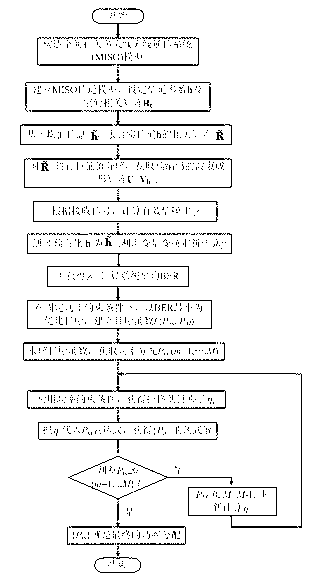Precoding method based on incomplete channel information in space correlation multiple inputs, single output (MISO) system
A spatial correlation and channel information technology, applied in the direction of space transmit diversity, diversity/multi-antenna system, advanced technology, etc., can solve the problems that the closed-form expression of power allocation is not given, the convergence speed is slow, and the processing time is prolonged. Achieve the effect of low cost, low complexity and low delay
- Summary
- Abstract
- Description
- Claims
- Application Information
AI Technical Summary
Problems solved by technology
Method used
Image
Examples
Embodiment Construction
[0028] Step 1: Establish a system model and a corresponding channel model; establish a space-correlated wireless MISO (Multiple Input Single Output) communication system model, the system has M a transmitting antenna and a single receiving antenna, the corresponding channel model can be expressed as a channel matrix h={ h m}, which can be modeled as: , where h w is the randomly varying part of the channel, R t is the transmit antenna correlation matrix, representing the channel covariance matrix.
[0029] Step 2: Determine the effective signal-to-noise ratio of the system; from the received signal matrix, the effective signal-to-noise ratio at the receiving end can be obtained ,in: , is the average SNR (signal-to-noise ratio), u im is the element of the beamforming matrix U, r is the code rate of space-time coding. { P m , m =1, … , M} for M The power control of each eigenbeam satisfies the following power constraints: , P m 30.
[0030] Step 3: Determine...
PUM
 Login to View More
Login to View More Abstract
Description
Claims
Application Information
 Login to View More
Login to View More - R&D
- Intellectual Property
- Life Sciences
- Materials
- Tech Scout
- Unparalleled Data Quality
- Higher Quality Content
- 60% Fewer Hallucinations
Browse by: Latest US Patents, China's latest patents, Technical Efficacy Thesaurus, Application Domain, Technology Topic, Popular Technical Reports.
© 2025 PatSnap. All rights reserved.Legal|Privacy policy|Modern Slavery Act Transparency Statement|Sitemap|About US| Contact US: help@patsnap.com



